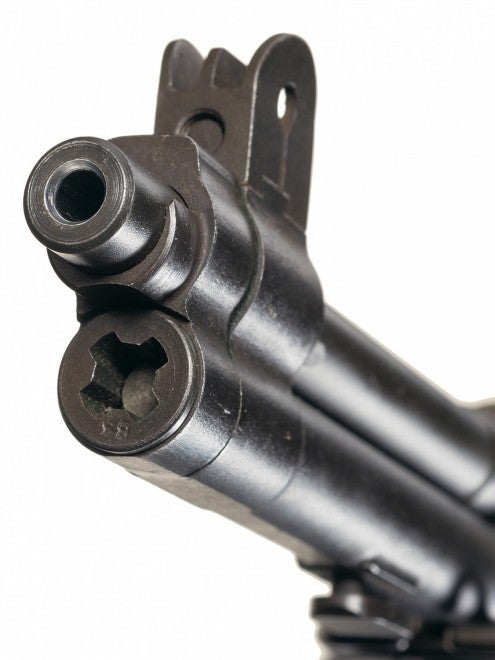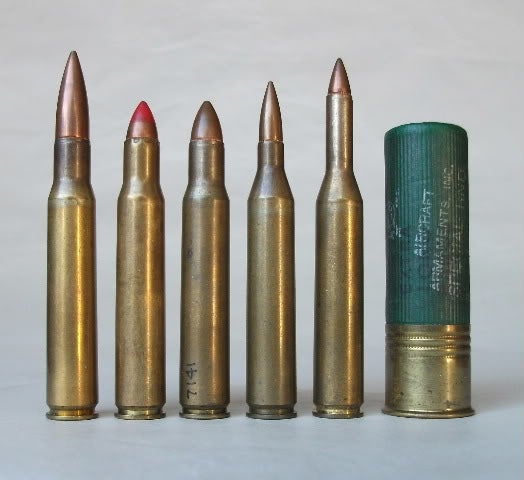Up for auction through Rock Island Auction Company is a rifle that is very significant to the history of the military .22 caliber rifle cartridge. Below are pictures of the rifle, an experimental M1 Garand chambered for the .22-06 Duplex caliber which was a part of the SALVO II test conducted in December of 1957:

The rifle has tape on both the stock and forend, most likely to identify it as being in a non-standard caliber. Image source: rockislandauction.com

The business end of the .22-caliber Garand. This rifle would fire two projectiles per shot. Image source: rockislandauction.com
Pages 13-16 of SPIW: The Deadliest Weapon That Never Was provide some background on the SALVO II test:
Regarding ORO’s “long-necked” Duplex and Triplex .30 M2 loadings, the results were extremely encouraging. These further studies substantiated the Hitchman report’s findings that bullets fired in a simultaneous salvo are independently potentially lethal, and therefore for each shot fired a sum of lethal probabilities existed, which increased the statistical kill probability dramatically over that of single-bullet firings. Indeed, ORO reported in the SALVO I results that .30 Duplex cartridges showed a 65% increase in kill probability over standard (Simplex) rounds. The Triplex loading produced a double hit rate of single bullets; further tests might even prove them superior to the Duplex loads.
…
Improvements made as a result of the SALVO I field test led to a further series of trials at Fort Benning in December, 1957. Dubbed naturally SALVO II, they sought to gather more meaningful data on measured hit probabilities. The end result was the first-ever true comparison of ammunition effectiveness under conditions realistically simulating actual combat. ORO found that the accuracy of aimed fired changed when variances in range, target exposure time, and degree of marksmanship skill were introduced. These fluctuations were painstakingly added to the basic equation, with the aid of the innovative ORO measuring techniques already in place for the hit probability studies.In sum, SALVO II confirmed to the ORO analysts that the target exposure time and the actual area presented by the target were the determining hit-probability factors. Target movement and degree of incoming enemy fire were the variables next in importance. On the ammunition side, the usefulness of ORO’s new standard-length-case Duplex concept was further borne out, and it was at this point that ORO recommended a 7.62x51mm version be perfected and adopted as standard for combat use. In the face of the Army’s hallowed marksmnship tradition, ORO stated flatly that accuracy requirements for any new shoulder rifle should be based on an intentional, built-in aiming error of three mils.
To the SALVO teams, there was now no question as to the effectiveness of multiple projectiles being delivered with each trigger pull. As noted, ORO had devicsed the Duplex bullet in the 7.62mm NATO case as the most expedient method of adopting this controlled dispersion theory. Soon, however, ORO switched allegiance to even more exciting and dramatic advances in hit probability, by marrying BRL’s concept of high velocity and consequent flat trajectory to the almost imperceptibly low recoil impulse of a lightweight, single flechette. ORO recommended that by following this path, a controlled-dispersion burst weapon could become a reality for every American combat soldier. This new weapon would be devastatingly lethal, regardless of his individual marksmanship abilities.
The .22-06, more properly called “Cal .22/30” was a powerful round for its caliber, utilizing the .30-06 Springfield cartridge as its base. It fired two 50-grain bullets at 2,975 ft/s (first bullet) and 2,897 ft/s (second bullet), for a combined muzzle energy of just under 2,600 Joules:

The calibers of the SALVO II test: From left to right, Cal .30 Ball M2, Cal .30 short neck Triplex, Cal .30 short neck Duplex, Cal .22/.30 short-necked Simplex, Cal .22/30 long-necked Duplex, AAI flechette shotshell. Image source: Ray Meketa, from forums.gunboards.com.
Six years ago, in 2009, another .22-06 Duplex SALVO rifle came up for auction through Gun Auction, and sold for just over $2,000. The rifle up for auction this time is expected to go for between $6,500 and $9,500, but maybe for one member of our audience such a price is worth owning such a significant piece of US small arms history!
Thanks to Daniel for the tip.
 Your Privacy Choices
Your Privacy Choices
